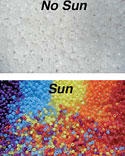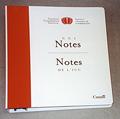All materials found in museum collections are subject to natural aging and degradation. This process can be accelerated by uncontrolled environments and/or inadequate housing.
Light, Temperature and Relative Humidity, and Pollutants effect the rate at which a collection is damaged. By controlling these factors of deterioration, you will greatly reduce the "aging" of your collection.
| MS104: An Introduction to Collections Preservation | |
| MS211: Preservation Environments |
Books and products we recommend:
 Preventive Conservation in Museums: Video Handbook compliments the 19-video series on preventive conservation. Each chapter is the script of one of the videos. Subjects include an introduction to preventive conservation, storage, the condition report, relative humidity and temperature, the care of textiles, protecting objects on exhibit, emergency and disaster planning, and closing a seasonal museum.
Preventive Conservation in Museums: Video Handbook compliments the 19-video series on preventive conservation. Each chapter is the script of one of the videos. Subjects include an introduction to preventive conservation, storage, the condition report, relative humidity and temperature, the care of textiles, protecting objects on exhibit, emergency and disaster planning, and closing a seasonal museum.
| Preventive Conservation in Museums Handbook | $35.00 |
 Framework for the Preservation of Museum Collections Wall Chart outlines various methods that can be used to avoid or control potential deterioration of museum objects. The rows list nine agents of deterioration (direct physical forces: thieves, vandals, displacers; fire; water; pests; contaminants; radiation; incorrect temperature and incorrect relative humidity), while the columns present three different levels at which the agent deterioration can be controlled. The procedures column outlines actions that can be taken. English/Spanish.
Framework for the Preservation of Museum Collections Wall Chart outlines various methods that can be used to avoid or control potential deterioration of museum objects. The rows list nine agents of deterioration (direct physical forces: thieves, vandals, displacers; fire; water; pests; contaminants; radiation; incorrect temperature and incorrect relative humidity), while the columns present three different levels at which the agent deterioration can be controlled. The procedures column outlines actions that can be taken. English/Spanish.
|
Preservation of Museum Collections Wall Chart | $29.00 |
 CCI Tech Bulletin #10 Silica Gel by Raymond H. Lafontaine
CCI Tech Bulletin #10 Silica Gel by Raymond H. Lafontaine
Provides information on the use of silica gel, how it controls RH, and how it is conditioned for use and maintained. Specific topics dealt with include: the problems of display case leakage, how silica gel fulfills the requirements of a humidity buffering agent, and the maintenance of a silica gel buffered display case.
| Silica Gel | $12.00 |

CCI Tech Bulletin #12 Controlling Museum Fungal Problems by Thomas J.K. Strang and John E. Dawson
Provides guidance on identifying a fungal problem, fungal problems in wood outdoors, and controlling fungi.
| Controlling Museum Fungal Problems | $12.00 |
 CCI Tech Bulletin #13 Controlling Vertebrate Pests in Museums by Thomas J.K. Strang and John E. Dawson
CCI Tech Bulletin #13 Controlling Vertebrate Pests in Museums by Thomas J.K. Strang and John E. Dawson
Examines the detrimental affect that rodents have on museum collections. Vertebrate animals can soil or destroy artifacts. Prompt identification of the pest and the use of suitable methods to control it are essential. In most cases, non-chemical methods can be used to control vertebrate pests in museums; chemical methods are also discussed.
| Controlling Vertebrate Pests in Museums | $12.00 |
 CCI Tech Bulletin # 15 Solving Museum Insect Problems: Chemical Control by John E. Dawson and revised by Thomas J.K. Strang
CCI Tech Bulletin # 15 Solving Museum Insect Problems: Chemical Control by John E. Dawson and revised by Thomas J.K. Strang
Intended to help museum staff understand commercial pest control operations. It describes chemical methods of controlling insects, and includes information on regulations, modes of action, and application methods necessary for the safe use of insecticides. A detailed guide helps in decision-making about the appropriate chemical method of control.
| Solving Museum Insect Problems: Chemical Control | $26.00 |

Vol.1 No.4
Indoor Generated Pollutants
| $5.00 |
| $5.00 |
 UV Detecting Beads The beads contain pigments that react with ultraviolet light from the sun, even on a cloudy day, turning them from white (no UV) to colored. Make your own UV light detecting bracelet by stringing the beads on a pipe stem or on a strip of rawhide. Great for teaching UV awareness! Use the beads to test the UV blocking effectiveness of sunblock, sunglasses, windows, etc. Available in five colors (purple, blue, yellow, orange and red), all beads are pale, off-white in the absence of UV light. The ultraviolet beads will cycle back and forth (to bright colors and back again) over 50,000 times.
UV Detecting Beads The beads contain pigments that react with ultraviolet light from the sun, even on a cloudy day, turning them from white (no UV) to colored. Make your own UV light detecting bracelet by stringing the beads on a pipe stem or on a strip of rawhide. Great for teaching UV awareness! Use the beads to test the UV blocking effectiveness of sunblock, sunglasses, windows, etc. Available in five colors (purple, blue, yellow, orange and red), all beads are pale, off-white in the absence of UV light. The ultraviolet beads will cycle back and forth (to bright colors and back again) over 50,000 times.
| 1,000 assorted beads | $48.00 | |
| 100 assorted beads | $5.00 | |
| 10 assorted beads | $0.55 |
 UV Detector This detector contains UV Detecting Beads inside of a clear plastic bottle. When the detector is shielded from UV radiation, the beads are white. When exposed to UV radiation (between 360 and 300 nm in wavelength), the beads turn purple. This detector can change color thousands of times.
UV Detector This detector contains UV Detecting Beads inside of a clear plastic bottle. When the detector is shielded from UV radiation, the beads are white. When exposed to UV radiation (between 360 and 300 nm in wavelength), the beads turn purple. This detector can change color thousands of times.
| UV Detector | $6.50 |
For general information on environment and collection concerns see:
 CCI Notes is the most important collection care publication a museum can acquire. A collection of over 90 technical leaflets written for a broad audience, topics in this continually expanding series range from "Removing Mould from Leather" to "Storage for Costume Accessories" and "Indoor Display of Industrial Collections." CCI Notes are illustrated, include supplier lists and a thorough bibliography. CCI Notes is available online at the CCI website.
CCI Notes is the most important collection care publication a museum can acquire. A collection of over 90 technical leaflets written for a broad audience, topics in this continually expanding series range from "Removing Mould from Leather" to "Storage for Costume Accessories" and "Indoor Display of Industrial Collections." CCI Notes are illustrated, include supplier lists and a thorough bibliography. CCI Notes is available online at the CCI website.
Note: this publication is not a compilation of the CCI technical bulletins, which must be purchased.
Links to related information on other sites:
Report on Conference on Collections Environments
http://palimpsest.stanford.edu/byform/ mailing-lists/cdl/1997/1115.html
Symposium of Collections Environments
(links/bibliographies)
http://www.si.edu/mci/english/professional_development/ past_courses_programs/courses/symposium_of_collections_environments.html
Furniture Care & Handling – The Environment
http://www.si.edu/mci/downloads/articles/furnbook.pdf
Practical Climate Control: A Selected, Annotated Bibliography
http://palimpsest.stanford.edu/byauth/ kerschner/ccbiblio.html

